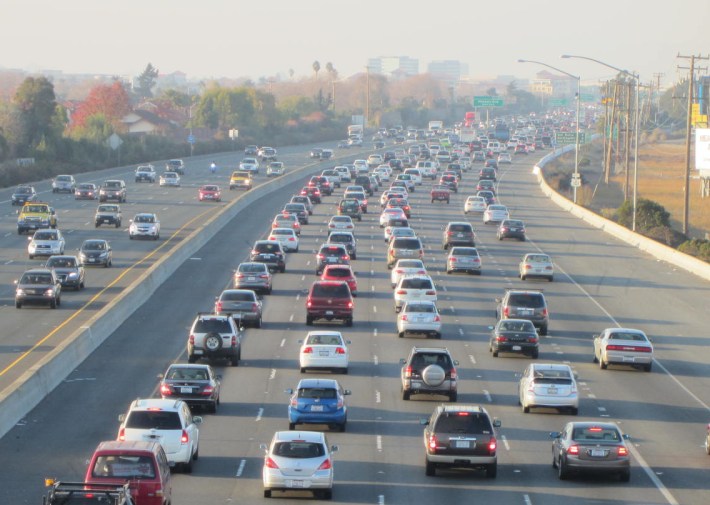
San Mateo County officials are moving forward with plans to widen Highway 101 in a futile attempt to pave their way out of traffic congestion.
The City/County Association of Governments (C/CAG) has dismissed a more effective and less costly proposal to avoid highway expansion by converting two existing traffic lanes to high-occupancy toll lanes, also known as express lanes.
"If we build more capacity for cars, what we'll end up with is more cars," said Joseph Kott, vice president of Transportation Choices for Sustainable Communities and a former transportation planning manager for C/CAG. "We'll have spent a lot of money to get more cars, and will live with all the consequences of having more cars. It's just not very sensible."
Rather than convert two of Highway 101's eight lanes to express lanes between San Bruno and Redwood City, C/CAG wants to keep all existing lanes free for solo drivers while expanding the roadway to 10 lanes.
C/CAG plans to conduct an environmental review that will only evaluate the addition of carpool lanes, which could then be converted to express toll lanes. The agency's board passed a resolution greenlighting the study on June 11.
But according to a 2013 report from Kott and TransForm called "Innovation Required: Moving More People with Less Traffic," converting existing lanes to express lanes would move 75 percent more people on 101 using 10 percent fewer vehicles, at far less cost, compared to building new, un-tolled carpool lanes. Even C/CAG admits that widening Highway 101 would increase driving and air pollution, and result in less transit ridership.
Initially, C/CAG did not include express lanes in its proposal at all, but will now study them for its widening.
Express lanes are free for buses and carpools, but allow solo drivers to access them for a price, which is adjusted throughout the day based on demand to keep the lanes free-flowing. Many members of the C/CAG board said they oppose any express lanes, while some don't even want to restrict the new lanes to high-occupancy vehicles, according to a recent San Mateo Daily Journal article.
A solution without new lanes would save an estimated $130 to $160 million in construction costs, according to TransForm's report. That figure was reaffirmed in a study [PDF] commissioned by C/CAG, which put the savings at about $151 million.
But C/CAG's study also concluded that converting existing lanes to express lanes would incur $238 million in transit operation costs over 20 years to accommodate commuters shifting from driving to transit -- putting the agency's total cost estimate of lane conversions above the cost estimate for expansion. That analysis conveniently failed to account for increased revenue from tolls, transit fares, or planned transit expansions, such as Caltrain electrification, already underway.
"Improving transit has a whole slew of benefits, not just reducing congestion for solo drivers," said Kott. "A cost-benefit analysis would show a different result. The value of the benefits to safety, public health, and mobility of the improved transit needed to avoid an expansion of Highway 101 far outweigh the costs."
C/CAG's analysis assumes that major increases in driving are inevitable, which becomes a self-fulfilling prophecy. "The traffic models used by C/CAG are predicated on past behavior, and they don't take into account the emergence of transportation management associations all along the Peninsula, or the growth of private transit along the 101 corridor," said Kott. "Are we going to see a continuation of high household trip generation rates? We definitely will if we keep building more highway capacity."
C/CAG's $16.5 million request for funds for the environmental review of the Highway 101 expansion will be up for approval by the SMCTA Board of Directors in September.





